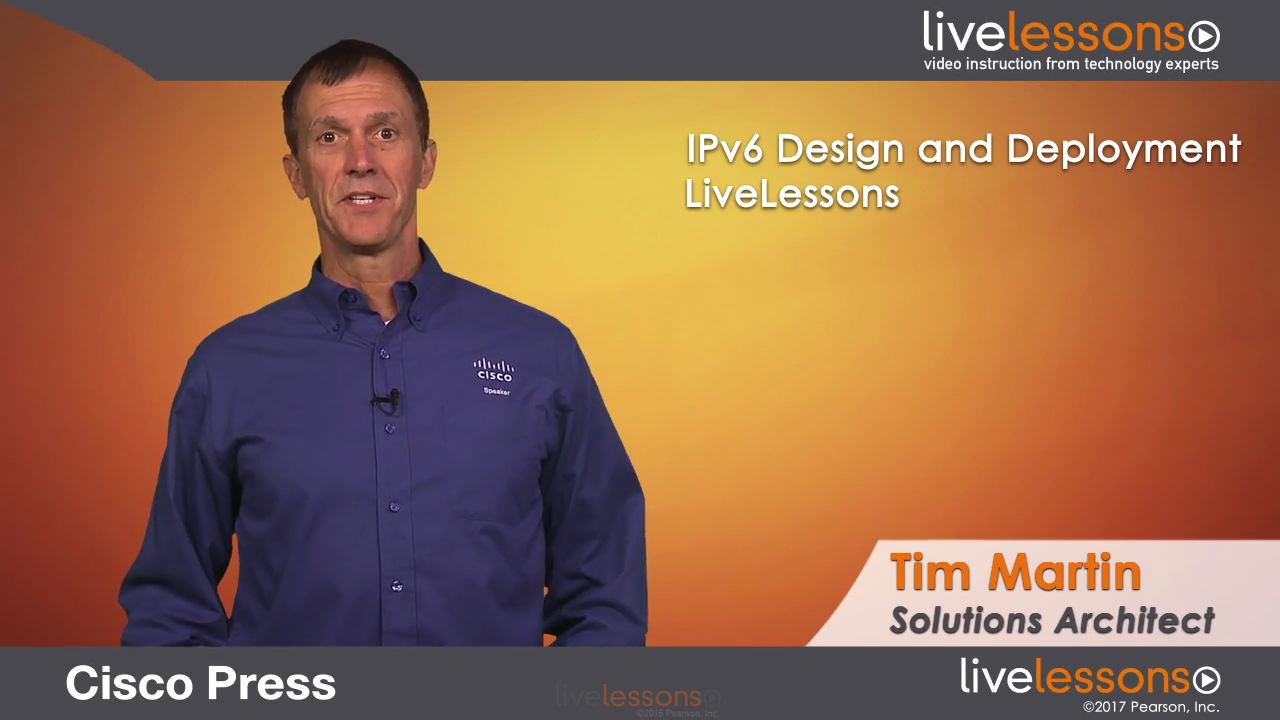IPv6 Design and Deployment LiveLessons
- By Tim Martin
- Published Nov 3, 2016 by Cisco Press. Part of the LiveLessons series.
- Copyright 2017
- Edition: 1st
- Online Video
- ISBN-10: 0-13-465551-6
- ISBN-13: 978-0-13-465551-2
Register your product to gain access to bonus material or receive a coupon.
More than 6 hours of video training covering all aspects of deploying and designing IPv6 in Cisco networks.
Description
IPv6 Design and Deployment LiveLessons is a comprehensive video training course that explains everything you need to know about deploying IPv6 in your enterprise environment. The information compiled here will aid you in leading your organization to a rich and full deployment of IPv6. You will find a balance between what you need to know to design IPv6 in the enterprise and what you need to know to deploy IPv6.
There are 10 lessons with more than 6 hours of video training in IPv6 Design and Deployment LiveLessons. Coverage includes
* Design Considerations
* IPv6 Protocol
* General Design Principles
* Host Role in IPv6
* IPv6 Network Services
* Campus Design Considerations
* Data Center
* Wide Area Networking
* Translation Techniques
* The Internet Edge
Skill Level
* Intermediate
What You Will Learn
* Topical, up-to-date information for IPv6 deployments
* The ins and outs of designing and deployment IPv6
Who Should Take This Course
Enterprise network architects
Network engineers
Network technicians
Operations technicians with a networking background
Former or current CCNAs, CCNPs, CCIEs, and CCDEs
Course Requirements
Prerequisite: A familiarity with IPv4, IPv6, and basic networking. This LiveLesson would be valuable to anyone concerned with network design and the deployment of IPv6 in the enterprise business environment.
New Player Enables Streaming and Download Access
Now you can stream and download videos for unlimited 24/7 online/offline access and ownership.
* Streaming–Watch instantly as the video streams online in real time; after purchase, simply click Watch Now to get started.
* Download–Download video files for offline viewing anytime, anywhere; after purchase, simply click the Download icon in the player and follow the prompts.
Plus, enjoy new player features that track your progress and help you navigate between modules.
About the Complete Video Course series
Complete Video Courses are Pearson’s flagship video learning solution. Designed specifically for IT pros, developers, sys admins, network engineers, and certification candidates, Complete Video Courses feature the highest quality video learning and interactive courseware led by the industry’s most respected author trainers. Complete Video Courses combine A-to-Z topical coverage with hands-on exercises and interactive assessments so you can master new skills and test your knowledge. This is ideal for certification exam prep and learning new technologies from the ground up. Exercises include dynamic hands-on simulations, real-world CLI demos, content exercises that help you truly learn the topics in each module, and interactive practice questions designed to test your knowledge while you study. Complete Video Courses are easy-to-follow, step-by-step, streaming video labs that allow you to train from anywhere on any device. Your purchase provides you with lifetime online access to the content.
Table of Contents
Module 1: Design Considerations
Lesson 1: Why IPv6, Why Now?
1.1: Examining Address Depletion
1.2: How the Infrastructure Providers Are Implementing IPv6
1.3: National Strategies for IPv6 Deployment
1.4: Your Operating Systems Are Already IPv6 Enabled
1.5: Understanding the Impact of the “Bring Your Own Device” Era
1.6: Understanding the Impact of “The Internet of Things”
Lesson 2: IPv6 Protocol
2.1: IPv6 Is Big and Size Matters
2.2: Introducing the IPv6 Address Family
2.3: Making Hex Easy
2.4: Differentiating Prefix from Subnet
2.5: Understanding Why Link Local Is Required
2.6: Visiting Headers and Friends
Lesson 3: General Design Principles
3.1: Preparing the Project Plan
3.2: Obtaining IPv6 Addresses
3.3: Determining Where to Start
3.4: Building the Address Plan
3.5: When to Use Tunneling
3.6: Examining Dual Stack
3.7: Dealing with Combined IPv4 & IPv6
3.8: Examining Link Local Only Infrastructure
3.9: Understanding Unique Local Addressing
Lesson 4: Host Role in IPv6
4.1: Understanding Host Provisioning Mechanisms
4.2: Decrypting the Flags, Bits & Timers
4.3: Surveying Relevant RFCs
4.4: Examining Windows in an IPv6 Environment
4.5: Examining Mac OSX in an IPv6 Environment
4.6: Examining Linux in an IPv6 Environment
4.7: Examining Chromebook in an IPv6 Environment
4.8: Examining Mobile OS’s in an IPv6 Environment
4.9: Examining Consumer Devices in an IPv6 Environment
Lesson 5: IPv6 Network Services
5.1: Deploying DHCPv6
5.2: Deploying IPv6 DNS
5.3: Managing IPv6 Addresses
5.4: Implementing IPv6 Multicast
5.5: Multicast Listener Discovery (MLD)
5.6: Understanding IPv6 Zero Configuration
5.7: Surveying IPv6 Management Tools
Module 2: Places In the Network
Lesson 6: Campus Design Considerations
6.1: Applied Concepts for Campus & Core
6.2: Comparing Layer 2 & Layer 3 Access
6.3: Examining First Hop Redundancy
6.4: Examining First Hop Security–Threat Identification
6.5: Examining First Hop Security–Attacks & Mitigation Techniques
6.6: Implementing Wireless Access Layer
6.7: Scaling the Distribution Layer
6.8: Securing the RP–OSPFv3, EIGRP
6.9: Implementing Unified Communications
Lesson 7: Data Center
7.1: Grasping Transition Stages
7.2: Considerations for Storage Area Networks
7.3: Examining Data Center Interconnect
7.4: Scaling the Neighbor Cache
7.5: Verifying Server Readiness
7.6: Planning for Application Migration
7.7: Considering Cloud Services
Lesson 8: Wide Area Networking
8.1: Understanding Remote Branch Design
8.2: Considering Dynamic Multipoint VPN
8.3: Exploring MACsec
8.4: Examining Multiprotocol Label Switching
8.5: Exploring Segment Routing
8.6: Deploying Remote Access VPN
Lesson 9: Translation Techniques
9.1: Understanding Network Address Translation
9.2: Considering NAT64
9.3: Implementing Server Load Balancing
9.4: Understanding Proxy Services
9.5: Examining Web Cache Control Protocol
9.6: Understanding Network Prefix Translation
Lesson 10: The Internet Edge
10.1: Surveying Design Scenarios
10.2: Implementing BGP Multihoming
10.3: Examining Multihome, Multisite
10.4: Considering Location Identification Separation Protocol
10.5: Mitigating Risk with Security
Online Video
- Your Price: $159.99
- List Price: $199.99
- About this video
Video accessible from your Account page after purchase.
Other Things You Might Like
- Open Shortest Path First (OSPF) Routing Protocol LiveLessons
- Online Video $159.99
